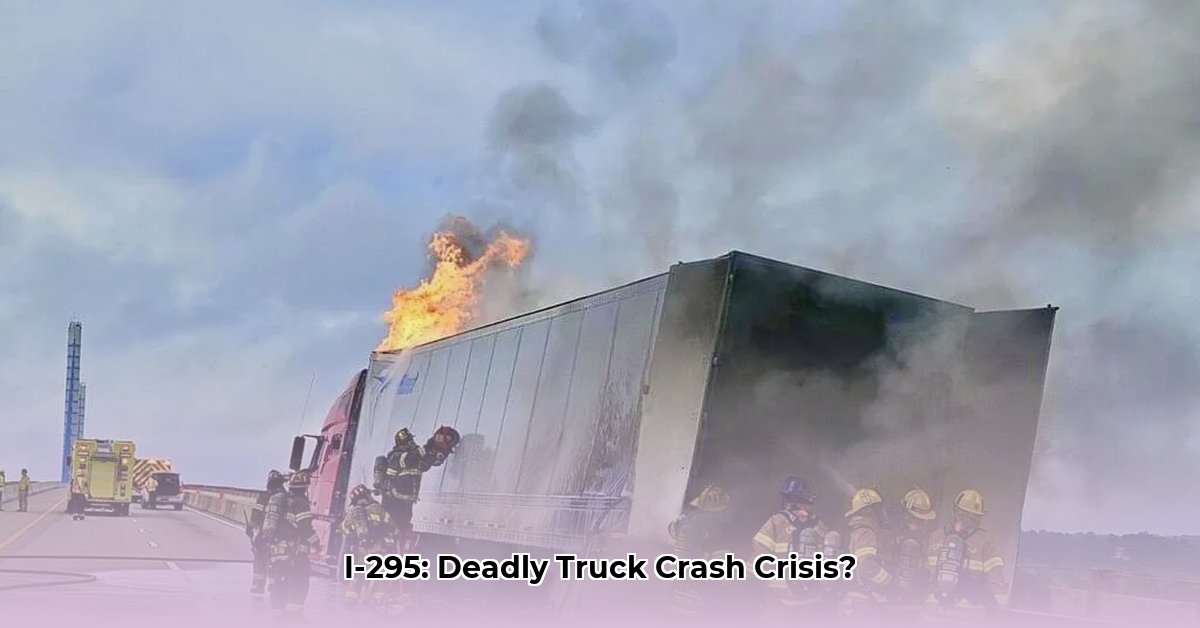
I-295 Tractor-Trailer Accidents: A Call for Urgent Safety Improvements
Recent tractor-trailer accidents on I-295 highlight a critical need for improved highway safety. Two significant incidents—one in February, the other in December—underscore a concerning trend demanding immediate attention. This article analyzes contributing factors and proposes actionable solutions to prevent future tragedies. Is the current regulatory framework sufficient to address the inherent risks associated with large commercial vehicles? The answer, based on recent events, is a resounding no. For more information on vehicle dimensions, see this helpful resource on truck height regulations.
Unpacking the Causes: Beyond Isolated Incidents
The February crash involved a potential road rage incident, while the December accident was a multi-vehicle pile-up, suggesting a complex interplay of factors. While immediate circumstances are known for each incident, a comprehensive analysis requires more detailed data on driver fatigue, vehicle malfunctions, and prevailing weather conditions. Without this crucial information, a complete understanding of the systemic issues remains elusive. Why are these accidents happening with increasing frequency? A lack of comprehensive data hampers effective analysis.
Systemic Issues: Addressing the Root Causes
The sheer size and weight of tractor-trailers present inherent safety challenges. Their significantly longer stopping distances compared to passenger vehicles heighten their vulnerability in emergencies. The resulting accidents often have devastating consequences. Are current regulations adequately addressing these inherent risks? Reactive measures are insufficient—proactive strategies targeting root causes are essential. How can we proactively mitigate the risks inherent to large commercial vehicles?
A Multi-Faceted Approach: Immediate and Long-Term Solutions
Addressing the I-295 safety issue requires a two-pronged approach: immediate interventions and long-term strategic improvements.
Short-Term Actions (Within One Year):
- Enhanced Law Enforcement Presence: Increased police patrols, especially during peak traffic hours, are crucial for enforcing aggressive driving laws and improving data collection on accident causes. This will facilitate the identification of trends and inform targeted interventions.
- Highway Infrastructure Upgrades: The Virginia Department of Transportation (VDOT) should prioritize improvements to road signage, lighting, and potentially add barriers in accident-prone areas. Improving emergency response times and accident scene cleanup efficiency is also critical.
Long-Term Actions (Over Three to Five Years):
- Mandatory Advanced Safety Technologies: Mandating Advanced Driver-Assistance Systems (ADAS) – including automatic emergency braking, lane departure warnings, and adaptive cruise control – for commercial vehicles will significantly enhance safety.
- Rigorous Driver Training: Implementing stricter driver training standards with a focus on defensive driving techniques and road rage prevention is necessary. Investing in driver wellness programs is equally crucial.
- Exploring Autonomous Technology: Carefully evaluating the potential of self-driving technology—where safe and appropriate—offers the potential for further safety improvements. Thorough risk assessments are paramount.
- Improved Data Sharing and Collaboration: Enhanced data sharing between state agencies and the Federal Motor Carrier Safety Administration (FMCSA) is vital for identifying and addressing systemic problems.
Shared Responsibility: A Collaborative Effort
Addressing I-295's safety concerns requires a collaborative effort involving multiple stakeholders:
| Stakeholder | Role |
|---|---|
| Virginia State Police | Enforcing traffic laws, collecting data, and investigating accidents. |
| VDOT | Implementing road and traffic safety improvements and conducting safety audits. |
| Trucking Companies | Maintaining vehicles, training drivers, and upgrading technology. |
| FMCSA | Establishing national safety standards, overseeing regulations, and analyzing data. |
Risk Assessment: Evaluating Proposed Strategies
The following table assesses the likelihood of success and potential negative consequences for each proposed strategy:
| Technology/Action | Likelihood of Success | Severity of Failure | Risk Level | Mitigation Strategies |
|---|---|---|---|---|
| Increased Police Patrols | High | Moderate | Medium | Data-driven patrol routing; optimized patrol allocation. |
| Infrastructure Improvements | Medium | High | High | Secured funding; thorough environmental impact assessments; stakeholder collaboration. |
| Driver Training Programs | High | Low | Low | Accident rate tracking; continuous training and refresher courses. |
| ADAS Implementation in Trucks | Medium | Moderate | Medium | Cost-benefit analysis; technological compatibility assessments; addressing data privacy concerns. |
Regulatory Review: A Crucial Next Step
The I-295 accidents necessitate a thorough review of current trucking regulations, including driver hours, vehicle maintenance, and driver qualification standards. Addressing road rage and firearm possession in commercial vehicles also requires attention. Stronger legal frameworks defining negligence and intentional harm are equally vital.
A Call to Action: Collaboration for Safer Roads
The recent I-295 accidents serve as a stark reminder of the urgent need for collective action. Drivers, law enforcement, regulatory bodies, and the trucking industry must collaborate to create a safer road environment for everyone. Only a coordinated and comprehensive approach will effectively mitigate the risks and prevent future tragedies.